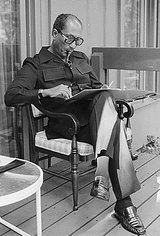[via Pierre Tristam
MiddleEast.About.com]
President Ronald Reagan’s Address to the Nation
October 6, 1981
Egyptian President Anwar Sadat was assassinated during a military parade in Cairo on Oct. 6, 1981. At 2:28 p.m. Eastern Standard Time in Washington, D.C., President Reagan addressed the nation, on television and radio, from the North Portico of the White House. His remarks follow. Today the people of the United States join with the people of Egypt and all those who long for a better world in mourning the death of Anwar Sadat.
President Sadat was a courageous man whose vision and wisdom brought nations and people together. In a world filled with hatred, he was a man of hope. In a world trapped in the animosities of thepast, he was a man of foresight, a man who sought to improve a world tormented by malice and pettiness.
As an Egyptian patriot, he helped create the revolutionary movement that freed his nation. As a political leader, he sought to free his people from hatred and war. And as a soldier, he was unafraid to fight. But most important, he was a humanitarian unafraid to make peace. His courage and skill reaped a harvest of life for his nation and for the world.
Anwar Sadat was admired and loved by the people of America. His death today—an act of infamy, cowardly infamy—fills us with horror.
America has lost a close friend; the world has lost a great statesman; and mankind has lost a champion of peace. Nancy and I feel that we have lost a close and dear friend; and we send our heartfelt sympathy to Mrs. Sadat, to his children, who were here such a short time ago.
Thank you very much.
[Anwar Sadat relaxes with his trademark pipe and paperwork during a break in negotiations at Camp David on September 9, 1978. The Camp David accords between Israel and Egypt were signed on sept. 17, opening the way for the 1979 peace treaty. White House photo.]
_______
What Sadat Was Celebrating that Day
Oct. 7, 1981 marked Egypt’s Armed Forces Day, so called in commemoration of the Egyptian Third Army’s launching of a surprise attack on that day in 1973 against Israeli forces occupying the Sinai since 1967. The Third Army pushed Israeli forces back toward Israel for several days until an American weapons airlift helped Israel turn the tide in what became known as the Yom Kippur war. Egypt’s Third Army was encircled in turn, but not annihilated. Israel and Egypt settled for stalemate—a settlement largely seen as a moral victory for Egypt and Egyptian President Anwar Sadat.
The war strengthened Sadat’s hand vis-à-vis Israel, enabling him to launch his next bold move to break the stalemate: his famous visit to Jerusalem in 1977, which opened the way for negotiations between Egypt and Israel, culminating in the Camp David accords of 1978 and the Egyptian-Israeli peace treaty signed in 1979.
Sadat and Egypt were celebrating all those accomplishments—Sadat celebrating the peace accord more than the rest of Egypt, however—on Oct. 7, 1981.
The Assassination
French Mirage jet fighters, part of the day’s pageantry, screeched overhead at the very moment when several soldiers riding in a truck that was part of the military parade jumped to the ground and strode toward the reviewing stand. Most people watching, including, presumably, the people in the stand, believed the soldiers were conducting a pre-arranged performance. In a way, they were.
One soldier threw a grenade while others opened fire at Sadat and his entourage. One soldier was seen in a semi-crouch, taking aim and firing. Pandemonium immediately broke out in the stands as people rushed for cover, trampling others who’d either been hit or were frozen in shock. Blood pooled in the stands immediately.
Sadat was rushed to Maadi Military Hospital, where he arrived without a heartbeat. He was pronounced dead at 2:40 p.m. local time due, according to a hospital bulletin, to “violent nervous shock and internal bleeding in the chest cavity, where the left lung and major blood vessels below it were torn.”
Hosni Mubarak, Egypt’s vice president at the time, assumed power and in a speech to the Egyptian nation seven hours after the assassination said that Egypt was “committed to all charters, treaties, and international obligations that Egypt has concluded.” That sent a sigh of relief whistling around the globe, but in Israel and Washington in particular, and less so in Egypt, where Mubarak used the assassination as an excuse to declare martial law. The law was subsequently referred to by its euphemism, the “emergency law.” It has remained in effect ever since. (Emphasis CAJ.)
The Attackers
The attackers included four enlisted men, an army major and a lieutenant. The major and two enlisted men were killed in the swarm around the reviewing stand, once other members of the military realized what was taking place. The rest were arrested. The attackers would eventually come to be identified as Islamist nationalists associated with the Muslim Brotherhood under the name of Islamic Jihad.
The group was subsequently found to have hatched the assassination plot with Al Gamaa al-Islamiyya, a Brotherhood offshoot that would , in the mid-1990s, develop ties with al-Qaeda and be chiefly responsible for the 1997 terrorist attack in Luxor on Nov. 17, 1997, when six men dressed in black attacked tourists visiting the famous site in Upper Egypt. Sixty-two men, women and children were killed.
Among the group’s leaders: Ayman al-Zawahiri, subsequently al-Qaeda’s Number 2. Zawahiri was tried and imprisoned for three years for his role in the plot, then expelled from Egypt. (Emphasis CAJ)
Al Gamaa al-Islamiyya accused Sadat of apostasy and condemned him for the peace treaty he’d signed with Israel. Not keen on irony, Sadat’s attackers had killed him the one day he celebrated what he and Egypt perceived as a victory over Israel.
On July 17, 1988, three assassination plotters, Mohammed Khames, Esam el-Kemary, and Ahmed el-Aswani, escaped from the Tura prison on the outskirts of Cairo. Police tracked down Khames and killed him in a gunfight. Aswani was wounded and rearrested. El-Kemary’s fate remains unclear.
In September 2003, Karam Zohdi, one of the plot leaders, who was serving a life sentence, was released from prison. In a July, 2003 interview, Zohdi had repudiated his role in the assassination, saying, in reference to the plot, that if he could turn back the clock, “I would interfere to prevent it.”
In late 1997, Al Gamaa al-Islamiyya had declared a unilateral cease-fire that went in effect in 1999.
Sadat’s Funeral and the United States
At Sadat’s funeral on Oct. 10, 1981, the United States was represented by three former presidents: Jimmy Carter, Gerald Ford and Richard Nixon. Ronald Reagan did not attend, ostensibly because of fears over his safety.
Among the other members of the American delegation to the funeral: Secretary of State Alexander M. Haig Jr., Defense Secretary Caspar W. Weinberger, former secretary of state Henry Kissinger, Sol M. Linowitz, lead negotiator on Mideast issues under Carter Administration, and Sam Brown, a 14-year-old South Carolina student who’d written a letter to Sadat in 1979, praising his efforts for peace, and visited Egypt at Sadat’s invitation (Brown got to see belly dancers and pyramids, but not Sadat, who stood him up on their lunch date).
“There was no sign of fear about Sadat,” Carter said in reaction to the assassination. “And I think he feels God will take care of him. He has a very remarkable sense of destiny.” Speaking on television the day after the assassination, Carter suggested that Sadat had peen planning to retire: “He told me that he wanted to step down from the presidency next year, and Vice President Mubarak would undoubtedly succeed him.” Sadat’s wishes may have been sincere. It is very unlikely, however, that Sadat, who, in the words of Egyptian writer and Nobel laureate Naguib Mahfouz, considered himself “a Pharaoh,” would ever have stepped down voluntarily.








